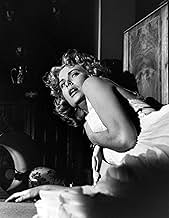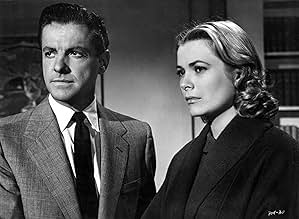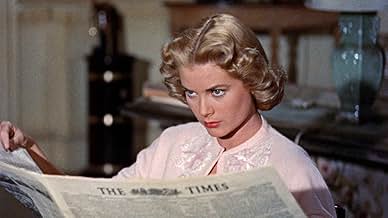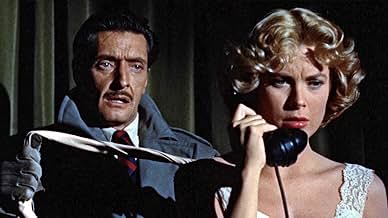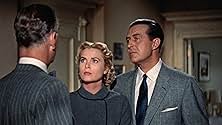Un ancien joueur de tennis décide de tuer sa femme pour hériter de son argent et se venger d'un cas qu'elle avait eu. Mais les choses ne se dérouleront pas comme prévu.Un ancien joueur de tennis décide de tuer sa femme pour hériter de son argent et se venger d'un cas qu'elle avait eu. Mais les choses ne se dérouleront pas comme prévu.Un ancien joueur de tennis décide de tuer sa femme pour hériter de son argent et se venger d'un cas qu'elle avait eu. Mais les choses ne se dérouleront pas comme prévu.
- Réalisation
- Scénario
- Casting principal
- Nomination aux 1 BAFTA Award
- 5 victoires et 3 nominations au total
- Banquet Member
- (non crédité)
- Detective
- (non crédité)
- Bobby Outside Flat
- (non crédité)
- Police Photographer
- (non crédité)
- Detective
- (non crédité)
- Woman Departing Ship
- (non crédité)
- Banquet Member
- (non crédité)
- Banquet Member
- (non crédité)
Résumé
Avis à la une
Cold Ray Milland plans and sets up the murder of his demure but faithless wife Grace Kelly by a virtual stranger who is urged on by the stick of exposure of his misdeeds and the carrot of GBP1,000 in used notes. Of course all of his convoluted plans go horribly or thankfully wrong, depending on your point of view, leading to an even more convoluted revised plan. When first seen when young I wasted my time because I wasn't paying attention at the critical moment so missed the point and didn't get it: the key is how did the baddie get into the apartment? It's incredibly verbose, being from a stage play after all and at times it seems nothing more than a radio show with pictures. The long scene setting and verbal sparring by Milland and Anthony Dawson is superb to hear - it's fascinating for its relentless poetry, and of displaying a now-dead world. I could never understand the attraction of 3D movies, least of all with this particular attempt, or why Kelly was continually uglified by the Hollywood machine when she never looked lovelier than in here when she was playing stressed out throughout.
I wonder if Hitch remembered the jokey murder scene he did in 1930 in Elstree Calling when Jameson Thomas realised he was murdering in the wrong apartment? Turn that key you have and go in, it's a remarkably literate film and as intricate inside as any lock.
Dial M for Murder succeeds on many levels, and it is largely thanks to some superb dialogue, written from a tricksy-yet-capable script that never gets too deep. The cast are a treat. Ray Milland is an absolute gem, extremely sly and dispassionate, yet a character so full of self-assurance that one almost sides with him. Grace Kelly completes her great year (she gave an Oscar-winning performance in The Country Girl and also starred in Rear Window) by emanating the poised, beautiful being, that is vulnerable, yet oddly unassailable. And it's weird in that even though she's cheating on her husband, you care for her a lot more than him (although that could do with the fact that he's trying to kill her...) And John Williams, as the police detective, is quite wonderful.
Alfred Hitchcock manipulates and enthrals his audience here like the master that he is. Each scene has a sense of direction, great pacing, and is staged realistically. Stunning full colour photography and a haunting, atmospheric score from Dimitri Tiomkin complete this great package. The ending, when it comes, feels a little too nice to be truly realistic, but that is my only major quibble with an otherwise highly entertaining, thrilling movie.
Time has not diminished this gem and it deserves its fame and status.
Hands down the father of noir-film.
Le saviez-vous
- AnecdotesJohn Williams won the 1953 Tony Award for Best Featured Actor in a Play for "Dial M for Murder" as Inspector Hubbard. He re-created the role in this movie.
- GaffesWendice throws a £100 bundle on a pink armchair. The money falls right at the back of the seat. A few minutes later, Swann takes the money which is now right in front of the armchair.
- Citations
Tony Wendice: How do you go about writing a detective story?
Mark Halliday: Well, you forget detection and concentrate on crime. Crime's the thing. And then you imagine you're going to steal something or murder somebody.
Tony Wendice: Oh, is that how you do it? It's interesting.
Mark Halliday: Yes, I usually put myself in the criminal's shoes and then I keep asking myself, uh, what do I do next?
Margot Mary Wendice: Do you really believe in the perfect murder?
Mark Halliday: Mmm, yes, absolutely. On paper, that is. And I think I could, uh, plan one better than most people; but I doubt if I could carry it out.
Tony Wendice: Oh? Why not?
Mark Halliday: Well, because in stories things usually turn out the way the author wants them to; and in real life they don't... always.
Tony Wendice: Hmm.
Mark Halliday: No, I'm afraid my murders would be something like my bridge: I'd make some stupid mistake and never realize it until I found everybody was looking at me.
- Crédits fousThe title is shown on a background of a British telephone dial; its MNO marking is replaced by a single large M which forms the single M of the title.
- Versions alternativesThe film had an intermission in its original 3-D release, although it is less than two hours in length.
- ConnexionsEdited into Histoire(s) du cinéma: Le contrôle de l'univers (1999)
Meilleurs choix
Détails
- Date de sortie
- Pays d’origine
- Langue
- Aussi connu sous le nom de
- Con M de Muerte
- Lieux de tournage
- Société de production
- Voir plus de crédits d'entreprise sur IMDbPro
Box-office
- Budget
- 1 400 000 $US (estimé)
- Montant brut aux États-Unis et au Canada
- 24 845 $US
- Week-end de sortie aux États-Unis et au Canada
- 12 562 $US
- 11 avr. 1999
- Montant brut mondial
- 45 313 $US
- Durée
- 1h 45min(105 min)
- Couleur
- Rapport de forme
- 1.66 : 1



